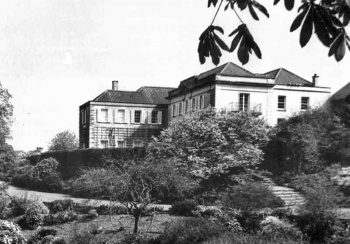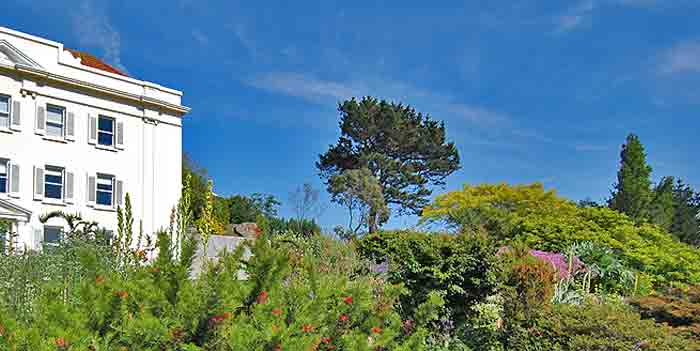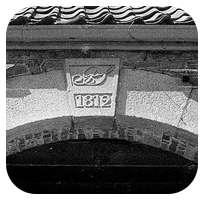History from a Jersey Archive presentation
At the heart of the Boulivot area of Grouville lies Radier Manor, a property with a history that can be traced back as far as the 18th century.
The current structure was originally a farmhouse. It appears on the Richmond map of 1795 and the 1849 Godfray map showing the farm and outbuildings with a pond and stream. The property is now owned by the Child-Villiers family, who were granted the title Lord Jersey by King James in 1693.
George Francis Child-Villiers, 9th Earl of Jersey, acquired what was then known as Radier House from Radier Ltd in 1951. It was remodelled and given the title Radier Manor at this time. The property had previously been sold to Radier Limited by Norman Adamson in 1947 and it was the Adamson Family who owned it during the Occupation.
Norman William Adamson’s son, also Norman, and his wife left the Island in June 1939. Norman senior’s wife, Edith, left the Island in June 1940. On her application to return to Jersey, completed in November 1943, she noted that she left Jersey on 21 June 1940 “at two hours notice”, leaving the house full of all their possessions, including all her father’s possessions’.
In July 1941 Radier was requisitioned by the German forces. The house remained in their hands until the end of the Occupation and in 1946, Edith applied to the Channel Islands Rehabilitation Scheme for assistance with repairs to the property.
The shells of the original farm outbuildings still exist and the archway to the granite courtyard has a keystone with 1812 and PS on it. PS stands for Pierre Simonet, Jersey`s most successful tobacco importer, and 1812 was when the farmhouse was built.
The manor [1], as it is now called, was remodelled to the vision of the 9th Earl when he moved there in 1947 and was further changed later. Georgian in style, it was partly inspired by some of the properties that used to belong to the Jersey family, including Osterley Park House in London.
The gardens were created from what was essentially scrubland. The heavily planted borders are filled with many varieties of plants, shrubs and mature trees, including a horse chestnut which is thought to be at least as old as the original farm at around 200 years. The gardens reflect those at Osterley Park House which were planted in the vision of the famous Georgian socialite, Sarah Sophia, Countess of Jersey, indeed the gardens house some of the items that resided in the grounds of Osterley, including the sundial below.
Simonet family
Arthur Simonet inherited Radier from his brother, Kenneth William Lee Simonet, in 1916. It was the Simonet family who owned Radier for the majority of the 19th century.
Arthur and Kenneth were two of the four children of William Simonet and on William’s death in 1912, Arthur inherited his father’s property and business in St Helier, with Kenneth’s share being the property at Radier.
Kenneth died in the [{Great War]] and his service is recorded in the Victoria College Book of Remembrance. Kenneth obtained a commission in the Jersey Militia on leaving school in 1899 and the following year he joined The Prince of Wales Own Yorkshire Regiment, becoming a Captain in 1909 and Major in 1916.
Most of his career was spent in India, but in December 1915 he was attached to the Black Watch and sent to Mesopotamia. He was badly wounded in an attack on the Turkish lines in January 1916. He went on to lead his men in a further attack and was mortally wounded.
Tobacco manufacture
Kenneth and Arthur’s father, William Simonet, lived at Radier with his family until his death in 1912. William was a tobacco manufacturer, who ran his business from his shop in Broad Street. Hospital Committee Minutes show that William supplied tobacco to the hospital in the late 19th and early 20th centuries – not very healthy by today’s standards!
In 1897 William was elected unopposed as the Deputy of Grouville. His term of office must have been successful as in 1901 the Jersey Weekly Press and Independent reported: ‘An influential deputation last Monday waited upon the Deputy, Mr William Simonet, at Radier. The Constable, acting as spokesman, in a brief speech explained the deputation’s mission and asked Mr Simonet to allow himself to be renominated to the post of Deputy in the forthcoming election. Mr Simonet said that in the face of such an influential deputation he could only accede to the wishes of his constituents.’
William had inherited Radier from his father, François Jean Simonet, who was listed on the 1881 census as a farmer of 40 acres employing five men and one boy. François had originally worked as a banker. He inherited Radier from his father, Pierre, in 1853. He married Jane Frances Gorle from Worcestershire at the British Church at Caen in 1839 in the presence of the British Vice-Consul.
Pierre was born in St Helier and married Ann Le Geyt in 1805 at the Town Church. It was Pierre who was the first Simonet owner of Radier, having purchased the property from Susanne Filleul in 1804. Pierre’s connection to Radier can still be seen on the property today with the datestone PS 1812, which is located on the archway to the courtyard.
In 1814 Pierre appeared in Court after he was reported to the Constable by George Aubin, Vingtenier of Grouville. Aubin’s report shows that he arrived at Pierre’s property in Grouville to levy the rates and was grossly insulted by Pierre, who told him he could go to the devil. Pierre eventually apologised for his conduct, saying that he meant no offence.
In September 1823 Pierre decided to try to align himself with the parish authorities by running for the office of Constable of Grouville. Pierre was running against Charles Bertram and there appears to have been a bit of electioneering taking place. The Chronique newspaper reported that, among others, Jean Le Vesconte was allegedly offered 200 francs to vote for Pierre.
The paper appeared to be on the side of Pierre’s rival, Charles Bertram, and it reported his victory by seven votes as a ‘triumph of the people against chicanery’.
Pierre was successful in a second bid to become Constable in 1826 and he served in the post until 1839. He lived at Radier until his death in 1853.
Occupants
In the 1881 census John Mourant (1830- ), unmarried farmer of 13 acres, is shown living here
The 1901 census shows households at Radier Farm, Radier Cottage and Radier. The latter was occupied by farmer Francois Amy (1848- ), his wife Mary Ann, nee Le Couillard, their son Francis (1884- ) and several farm workers
Old Jersey Houses
Joan Stevens' Old Jersey Houses [2] describes the property as Radier (not Manor) and says that in the 18th century there was a group of four buildings.
"The original house faced south, and appears to be 18th century. The west wing must have been added a century later, and considerable improvements have been made in recent years."




